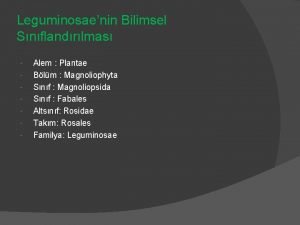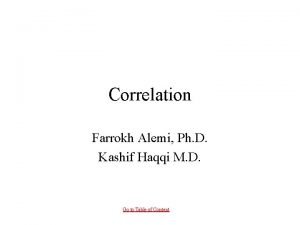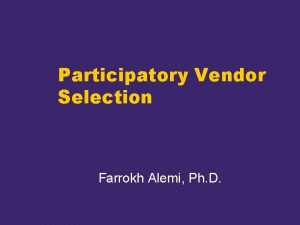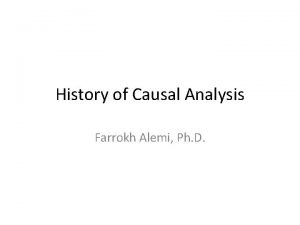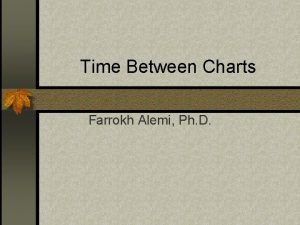Farrokh Alemi Ph D falemigmu edu 703 893

















- Slides: 17

Farrokh Alemi, Ph. D falemi@gmu. edu 703 893 3799 Aryan Mazloum Outcome Based Prescribing of Citalopram

Right Medication from Start Personalized Analysis

My Antidepressants Doesn’t Work Y R T & ER Y TR OTH AN Picture taken from http: //www. time. com/time/health/article/0, 8599, 1905083, 00. html#ixzz 0 k. WKdxl. NH

False Start for Majority of Patients Percent in Remission 100% 80% 60% 40% 20% 0% 37% Start with citalopram 56% 62% 67% 2 nd 3 rd medication 4 th medication

Source of Data: STAR*D

Star*D 4, 041 major depression from 41 Clinics

STAR*D Demographic data (gender, age, race) Medical History (cardiovascular, hematopoietic, eyes, gastrointestinal, renal, genitourinary, musculoskeletal, neurological, psychiatric, respiratory, liver, and endocrine diagnostic disorders)

STAR*D Demographic data (gender, age, race) Medical History (cardiovascular, hematopoietic, eyes, gastrointestinal, renal, genitourinary, musculoskeletal, neurological, psychiatric, respiratory, liver, and endocrine diagnostic disorders) Comorbidities (Alcohol, Cannabis, Panic, Post-traumatic Stress, and Generalized Anxiety disorders)

Who will respond to citalopram? 50% reduction in Hamilton Depression Rating Scale

Confounding with Neurological Disorders Cases Age 41+ 395 Age 18 -41 345 Gender Female 491* Gender Male 249* Race White 557 Race Not-White 183 No comorbidities 24** Heart 145** Vascular 218** Hematopoietic 81* Eyes 442** Gastrointestinal 397** Renal 65** Genitourinary 268** Musculoskeletal 417** Controls 1102 1061 1299* 864* 1726 437 300** 595** 482** 160* 841** 694** 89** 417** 850** Cases Psychiatric Illness 171** Respiratory 319** Liver 102** Endocrine 245** Alcohol Abuse 43 Cannabis 12 Panic 38 Generalized Anxiety 51 Total 740 Controls 389** 595** 149** 452** 110 31 86 114 2, 163

Method of Data Analysis: Sequenced Causal Networks

Average Age of Occurrence of Comorbidities

Average Age of Occurrence of Comorbidities Later Events Do Not Influence Earlier Events

Network Predictive of Remission

Example Conclusion Citalopram Is Not Helpful for Patients with PTSD or Neurological Disorders

Impact of Neurological Disorders & PTSD on Response Common Disorders Cases Remission Odds Ratio Neurological Disorder 740 332 11. 80* 0. 74 Post-Traumatic Stress Disorder 158 56 8. 31* 0. 53 * Significant at alpha 0. 05 X 2

• Could we help You?
 Barcode history
Barcode history Kök ayaklılar
Kök ayaklılar Plantae alemi
Plantae alemi Monera alemi
Monera alemi Flora bölgeleri nereleridir
Flora bölgeleri nereleridir Cnler
Cnler Decimal number equivalent to binary number 1110101 is
Decimal number equivalent to binary number 1110101 is Ucc 2-703
Ucc 2-703 Estimation word problems
Estimation word problems Kde inclusion of special populations
Kde inclusion of special populations Medical waste management ppt
Medical waste management ppt Edu.sharif.edu
Edu.sharif.edu Ilias yengage
Ilias yengage Scott kirkby
Scott kirkby Baylor edu estimator
Baylor edu estimator Ksre.ksu.edu
Ksre.ksu.edu Www.soran.edu.iq
Www.soran.edu.iq Http //www.phys.hawaii.edu/ teb/optics/java/slitdiffr/
Http //www.phys.hawaii.edu/ teb/optics/java/slitdiffr/


